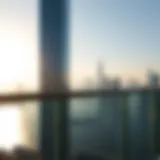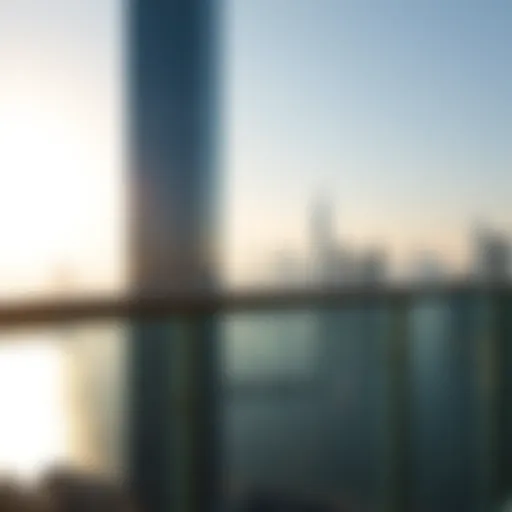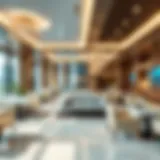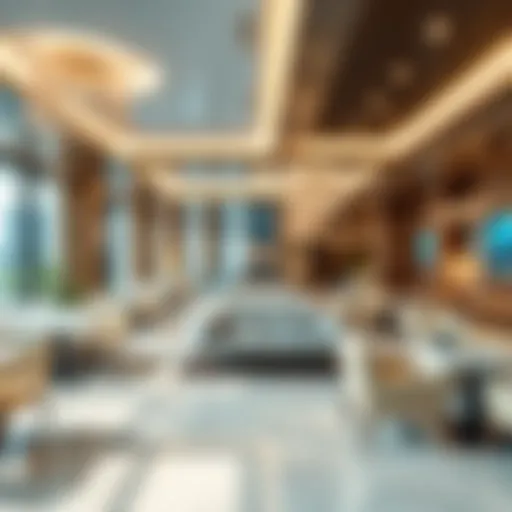Exploring the Red Line of the Dubai Metro
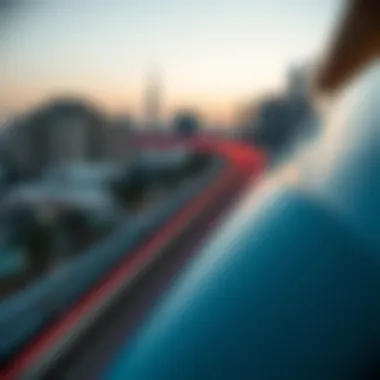

Intro
The Red Line of the Dubai Metro is not just a public transport system; it represents the pulse of a rapidly developing metropolis. Stretching across the heart of Dubai, this rail line connects vital regions and is instrumental in enhancing access and mobility for residents and tourists alike. Understanding this line is crucial for anyone interested in the real estate landscape of Dubai, urban planning, or even just efficient travel in the city.
The Significance of the Red Line
Dubai's Red Line, operational since 2010, showcases the city’s ambition to integrate cutting-edge technology with urban development. With each station, it serves not just to transport people but also to shape the neighborhoods surrounding it. Investors and homebuyers should take note; each station correlates with real estate opportunities that are often linked to the metro's accessibility.
Market Trends
Current Market Analysis
As of 2023, the areas adjacent to the Red Line are witnessing an upswing in property values. Neighborhoods like Downtown Dubai, Business Bay, and Dubai Marina have become particularly desirable, thanks in large part to their proximity to metro stations. Given the convenience of transport, potential residents are keen to find homes that provide easy commutes to work or leisure destinations.
Recent studies indicate that properties within walking distance of the Red Line could see price growth averaging around 15-20% in the next few years. This growth is fueled not only by the convenience offered by the metro but also by the ongoing developments in and around these areas.
Future Projections
Looking ahead, the future appears bright for areas serviced by the Red Line. Plans are in place to expand the network, including potential connections to emerging districts such as Dubai South and the Expo 2020 site. These expansions will likely enhance the attractiveness of neighborhoods located along the route.
Experts project that demand for homes near the metro is set to further spike, particularly as Dubai steps into a more advanced stage of its urban development.
Property Insights
Neighborhood Comparisons
- Downtown Dubai: A lively hub that hosts the iconic Burj Khalifa and Dubai Mall. Proximity to the Red Line here makes it a prime target for luxury investments.
- Business Bay: This area is rapidly developing into a commercial epicenter. Its access to the Red Line makes it attractive for office spaces and modern apartments alike.
- Dubai Marina: Well-known for its waterfront lifestyle, the metro line boosts its appeal for both residents and tourists.
Property Types Explained
With a diverse range of properties available near the Red Line, potential buyers have options:
- Luxury Apartments: Often high-rise with stunning views, ideal for investors looking for high rental yields.
- Affordable Housing: Available in various neighborhoods, aimed at young professionals and families.
- Commercial Properties: With growing business districts, office spaces near metro stations can offer lucrative opportunities.
"Dubai's Red Line is more than just a metro; it's a vital thread weaving the fabric of modern urban life, knitting together communities and economic growth."
Investors, homebuyers, and urban planners stand to gain significantly from understanding the emerging market trends and property insights associated with the Red Line of the Dubai Metro. To explore more about Dubai's rapid urbanization and its impact on real estate, consider checking resources like Wikipedia, Britannica, or visit forums such as Reddit.
By keeping a close eye on these trends, stakeholders can make informed decisions that align with the evolving landscape of this vibrant city.
Prolusion to the Dubai Metro
The Dubai Metro has transformed public transportation in the city, making it a central artery that connects various districts and urban landscapes, allowing for seamless commutes and enhanced accessibility. Its establishment represents a leap forward in modern infrastructure, echoing Dubai’s ambition to be at the forefront of urban development and innovation. This article will shed light on this sophisticated system, focusing primarily on the Red Line, which serves as a cornerstone of the metro network.
Historical Context
When one considers the history of the Dubai Metro, the ambition of Dubai's leadership becomes clear. The metro's inception can be traced back to the early 2000s, a period marked by rapid urbanization and the need for efficient transit solutions. In 2005, the Dubai Roads and Transport Authority (RTA) announced the project, and in 2009, the Red Line was officially opened for public use. The project was envisioned not just to ease traffic congestion, but to also foster a culture of public transit usage among residents and visitors alike.
Throughout its planning and construction phases, significant attention was paid to sustainability and technological integration. The metro is fully automated, powered by cutting-edge technology, which streamlines operations and enhances safety for its users. The development also adhered to stringent safety regulations, reflecting Dubai’s priorities in creating a reliable and modern transport network.
Metro System Overview
The Dubai Metro is impressively designed, consisting of two major lines: the Red Line and the Green Line. Together, they stretch over fifty kilometers, making it one of the longest automated rail networks in the world. The Red Line alone spans approximately 52.1 kilometers, connecting key areas such as the Dubai International Airport, the Burj Khalifa, and the iconic Dubai Mall.
The metro not only serves as a means of transport but also as a tool for urban development, linking commercial centers, residential areas, and cultural landmarks. With 29 stations along its route, the Red Line integrates seamlessly with various modes of transportation, including buses and taxis, ensuring that travelers can transition easily from one form of transport to another.
Moreover, each station is designed with a user-friendly approach, catering to a diverse demographic of commuters. Facilities such as ticket machines, information kiosks, and signage in multiple languages reflect the multi-national audience that Dubai attracts.
"The implementation of the metro system not only enhances connectivity but also stands as a testament to Dubai's progress on the global stage."
Understanding the Dubai Metro, and particularly the Red Line, opens a window into how urban transportation can be effectively integrated into city life, providing insights for investors, urban planners, and residents alike. It exemplifies the city’s commitment to innovation and efficiency — qualities that make the Dubai Metro an essential subject of exploration.
Red Line: An Overview
The Red Line is more than just a segment of the Dubai Metro; it is a lifeline that connects various parts of the city, reflecting both the ambition and pace of development in this bustling metropolis. As the first and longest line in the system, it covers 52 kilometers, traversing key districts and pivotal landmarks. Understanding the Red Line provides insights into how it enhances commuting efficiencies and shapes urban dynamics.
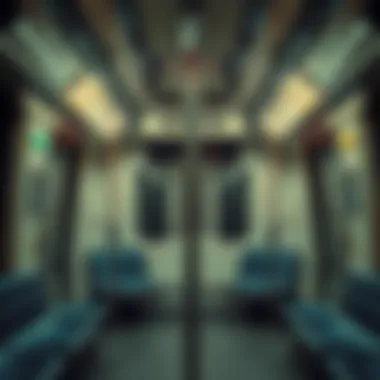
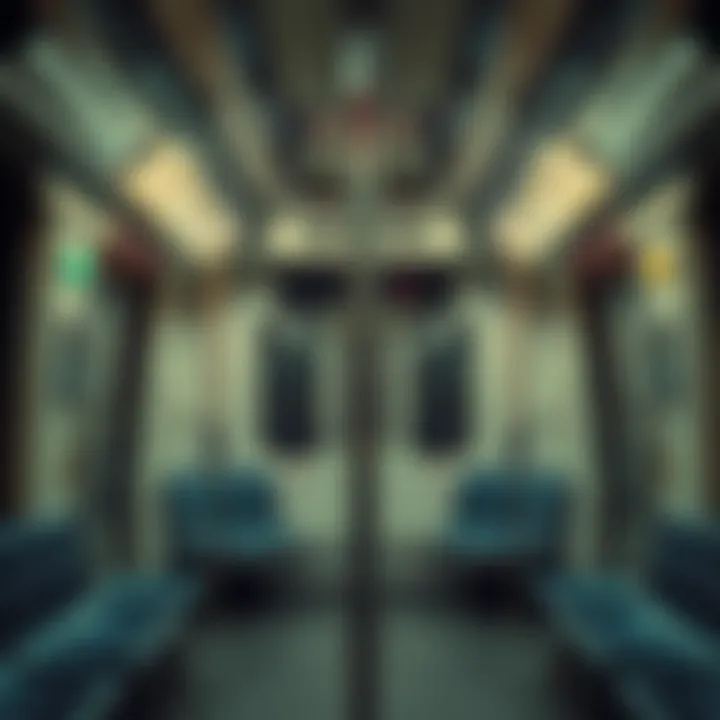
One can't overlook the strategic significance of the Red Line. It serves as a vital connector for residents and visitors alike, linking major tourism hotspots, business hubs, and residential areas. The reduction in traffic congestion due to the Metro’s operation factorially enhances the urban experience, underscoring the line’s importance in promoting Dubai as a modern urban center that embraces mobility.
Route Details
The Route of the Red Line showcases a masterclass in urban transport planning. Starting from Rashidiya in the northeastern portion of the city, the line winds southward, passing through 29 stations. Stops like Burj Khalifa/Dubai Mall Station and Union Station act as intersections of both transit and tourism, offering strategically placed access points for travelers and city dwellers.
Along its journey, the Red Line intersects with numerous important roads, making transfers efficient with various transport modes, including buses and taxis. This seamless integration promotes a level of convenience that is not just appreciated, but necessary in today’s fast-paced urban living. Each station carries its unique atmosphere and cultural touchpoints, embodying local character amid modern engineering. The pathway itself is adorned with art installations and architecture, inspiring awe not just for its functionality, but its aesthetic appeal.
In terms of efficiency, the trains run every 3-5 minutes during peak hours, accommodating up to 200,000 passengers daily. This operational capacity fuels not only individual commutes but also the broader economic activities around the stations.
Key Terminus Stations
Identifying the key terminus stations along the Red Line brings to light their significant roles within the transport network:
- Burj Khalifa/Dubai Mall Station: This station is a quintessential symbol of Dubai’s ambition. Located strategically near the world’s tallest building and a premier shopping destination, it serves thousands of visitors every day, highlighting the fusion of leisure and transit.
- Union Station: Acting as a central hub, Union Station links multiple Metro lines, creating a pivotal interchange for commuters. Its importance cannot be understated, as it connects not just lines but also cultures and neighborhoods across the city.
- Deira City Centre Station: With proximity to major business districts and shopping centers, this station caters to a diverse demographic. It's an essential node in the transport network, allowing seamless transitions for business professionals and shoppers alike.
Each of these terminus stations offers more than mere connectivity; they encapsulate the spirit of Dubai’s evolution as a city that aims high while staying grounded in community engagement.
"The Red Line is not simply a means of getting from point A to B; it is a gateway to the experiences that shape the life of Dubai itself."
Through its operational framework and significance, the Red Line demonstrates how thoughtful urban transport planning can effectively foster economic vibrancy and enhance the quality of life in a rapidly growing city. The incorporation of advanced technology ensures that this line remains up to date with the demands of the city, continually adapting to enhance everyday experiences for its users.
Station Analysis
Understanding the station analysis within the context of the Red Line of the Dubai Metro is crucial for grasping the network's overall impact on the city's transportation system and urban fabric. Each station serves not only as a stopping point for commuters but also as a hub for economic activity, connectivity, and urban development. The significance of these stations goes beyond simple transit; they are indicators of the regions they serve and pivotal elements in the planning and enhancement of Dubai’s public transport offerings.
The Red Line features strategically located stations, making it easier for residents and visitors to navigate through Dubai's stunningly diverse localities. By examining their unique characteristics and functions, we can see how they contribute to the city's liveability and economic growth. Each station tends to reflect aspects of its surroundings, whether it be through proximity to shopping hotspots, cultural landmarks, or residential areas. This symbiosis of transportation and local life is worth exploring in detail.
Major Stations and Their Significance
Burj Khalifa/Dubai Mall Station
The Burj Khalifa/Dubai Mall Station is emblematic of the Red Line’s role in enhancing accessibility to Dubai’s premier attractions. As the gateway to the Burj Khalifa, the tallest building in the world, and the expansive Dubai Mall, it draws a constant stream of tourists and residents alike. What makes this station particularly noteworthy is its direct linkage to these major attractions, which elevates it from merely a transit point to a cornerstone of Dubai’s tourism infrastructure.
The station boasts a striking design that mirrors the grandeur of the structures it serves. Its spacious concourse is tailored to handle heavy foot traffic, especially during peak tourist seasons. However, it can become congested, especially on weekends or holidays when hordes of visitors flock to the mall and tower, underscoring the need for ongoing management and enhancement of the infrastructure to maximize efficiency.
Union Station
Union Station stands as a critical junction within the Dubai Metro network. It connects the Red Line with the Green Line, showcasing its importance in ensuring seamless transfers across lines for daily commuters. This station is strategically located near important business districts and government offices, making it a crucial area for professionals in Dubai.
The key characteristic of Union Station is its accessibility; it features wide entry points and elevators to cater to various passenger needs, reflecting a commitment to inclusivity. However, its central location does come with challenges, as it often experiences high volume during rush hours. This pressure can lead to delays and overcrowding, highlighting the need for more effective crowd control measures during peak times.
Deira City Centre Station
Deira City Centre Station taps into a bustling retail environment, serving both as a transit point and a shopping destination for many locals and visitors. Its link to the Deira City Centre mall positions it perfectly for capturing consumer foot traffic and thereby boosting local commerce.
What stands out about Deira City Centre Station is how well it integrates different modes of transport. With nearby bus stops and easy access to taxi services, the station functions as a multimodal transport hub, enhancing its utility for a wide range of passengers. However, the station's location in an older part of Dubai means that it occasionally faces challenges related to outdated infrastructure and accessibility improvements.
Accessibility Features
Accessibility is a cornerstone of modern transport systems, and the Red Line does not fall short in its dedication to ensuring that all passengers can utilize its facilities with ease. Key features include elevators and escalators at major stations, tactile guidance systems for the visually impaired, and designated spaces for individuals with mobility issues.
This focus on accessibility reflects current trends in urban transport planning, where inclusivity and ease of use are prioritized. As urban planners and stakeholders look towards future developments, the emphasis on making public transport systems more user-friendly will remain a pivotal discussion point within the broader context of Dubai's transport strategy.
Technology and Safety
The realm of technology and safety in the context of the Red Line of the Dubai Metro is not merely ancillary but a cornerstone that underpins the entire system. In a bustling metropolis like Dubai, where the stakes of mobility and safety intertwine, leveraging advanced technology becomes indispensable. A seamless transit experience is a combination of cutting-edge operational technology and stringent safety protocols, both working in concert to create a reliable infrastructure.
Operational Technology
Modern transportation systems rely heavily on sophisticated operational technologies. The Dubai Metro adopts an intricate blend of automated control systems, ensuring efficient train operations and scheduling. This railway line is equipped with fully automated, driverless trains, operated by a system that utilizes advanced signaling technology. With sensors and controls transmitting real-time data, these trains achieve optimal frequencies, preventing overcrowding during peak hours and enhancing the overall commuter experience.
Real-time monitoring systems are pivotal; they provide operational teams with the necessary tools to intervene proactively, should there be a technical issue or operational disruption. This foresight reduces delays, ensuring a smoother journey for passengers. Moreover, the integration of mobile applications allows commuters to track train schedules, receive alerts, and access route information—all with a few taps. These features enhance the overall reliability of the system, making the Red Line not only a transit option but a tech-savvy innovation in urban mobility.
Safety Protocols
Safety is paramount when discussing any public transportation system, and the Red Line is no exception. With the intent to foster rider confidence, various safety protocols have been meticulously established. These protocols encompass multiple aspects, from train operation to station security measures.
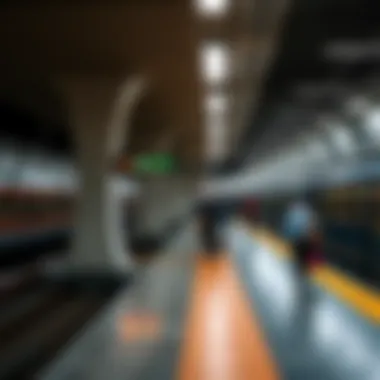
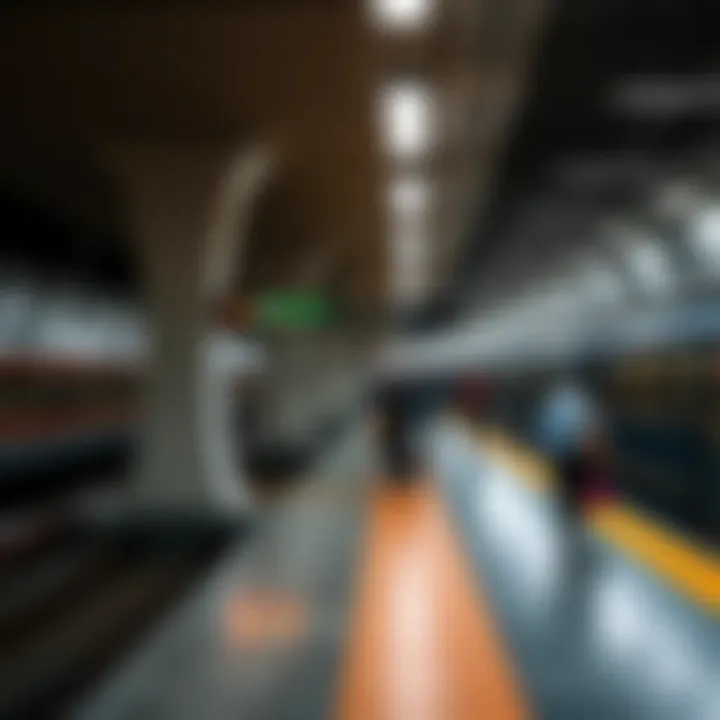
Firstly, the design of the trains includes robust fail-safes such as emergency brakes and communication systems connecting the train to control centers. Staff undergo rigorous training to ensure efficiency in handling emergencies. Additionally, each station is fortified with CCTV surveillance, security personnel, and emergency response plans to deter potential incidents and to manage crises if they arise.
Moreover, the implementation of fire and evacuation procedures, coupled with well-marked signage in both Arabic and English, ensures passengers are informed and prepared in case of emergencies. Such layers of safety create a holistic safety net that not only complies with national and international safety standards but also resonates with the city’s dedication to maintaining a secure environment for its inhabitants and visitors. This approach reflects a commitment to fostering a trustworthy public transportation system.
In summary, the blend of operational technology and safety measures within the Red Line of the Dubai Metro illustrates a comprehensive strategy aimed at delivering both efficiency and security, fundamental for encouraging increased urban mobility.
Understanding these elements is crucial not just for commuters, but also for investors and urban planners who must measure the viability and potential growth trajectory of projects linked to this vital transportation vein.
Economic Impact
The blade of progress that the Red Line almost carves through the heart of Dubai has vast economic implications. Not merely a transit route, it acts instead as a catalyst for growth in various sectors. Its integration into the daily lives of both residents and tourists is undeniable. It’s not just about getting from point A to point B; it’s about reshaping the economic landscape.
Influence on Local Real Estate
The emergence of the Red Line significantly altered the dynamics of local real estate. Previously neglected areas found themselves buzzing with activity, and developers took notice. Properties near metro stations saw a surge in demand. The sheer convenience of metro access makes them attractive to buyers looking for easy commuting options.
- Key Points on Real Estate Influence:
- The proximity to stations translates to higher real estate prices.
- Investments in urban developments are amplified, as developers can bank on foot traffic.
- A growing population in these areas stimulates renovations and infrastructure upgrades.
For example, the Burj Khalifa/Dubai Mall Station has spurred not just residential constructions but also mixed-use developments where commercial and residential units coexist. This blending of spaces heightens the value proposition for both homeowners and businesses alike, creating a vibrant community atmosphere.
Boosting Business Opportunities
With a robust transportation network brought forth by the Red Line, businesses have flourished in ways previously unimaginable. New ventures pop up like daisies after a rainstorm, capitalizing on the influx of consumers arriving via the metro.
- Business Aspects Enhanced by the Red Line:
- Accessibility leads to higher foot traffic for shops and restaurants adjacent to stations.
- Business services catering to commuters, such as dry cleaning or quick-service dining, have emerged.
- The line fosters connections between tourists and local businesses, driving sales and visibility.
Offices with a metro station within earshot are now seen as an asset rather than a mere location. Companies are eyeing these prime spots for headquarters, knowing well the convenience will attract talent eager for a stress-free commute.
The economic reverberations from the Red Line aren’t limited to mere convenience; they ripple through communities, altering lifestyle patterns, and thereby reshaping Dubai's urban tapestry.
In summary, it’s evident that the Red Line has established new economic paradigms, influencing real estate dynamics and injecting vitality into business opportunities. For investors and stakeholders, understanding these trends could yield substantial dividends in the evolving market.
For additional insights about the Dubai Metro's effect on the economy, check out Dubai's Economic Development or visit Wikipedia on Dubai Metro.
Urban Development
The Red Line of the Dubai Metro is not just a way to navigate the city; it represents a transformative force in urban development. As one of the most populated and bustling areas of the UAE, Dubai's growth has demanded a robust transportation system that fosters connectivity while shaping the urban landscape. This section explores how the Red Line contributes to effective urban development by addressing specific elements, the benefits it brings, and key considerations surrounding it.
Effects on Urban Planning
Urban planning in Dubai has witnessed a significant paradigm shift thanks to the Red Line. The line stretches across critical districts, effectively altering land-use patterns and driving growth in surrounding areas. Cumulatively, it presents an opportunity for planners to develop mixed-use spaces that combine residences, offices, and leisure amenities. Major stations, such as Burj Khalifa/Dubai Mall and Union, become focal points for comprehensive development, leading to more compact cities.
For example, the area around Union Station has seen a surge in high-rise buildings and commercial spaces, thereby attracting not just local residents but also international businesses. There is a synergy between the Metro and urban planning principles that emphasize walkability and public spaces, improving not only accessibility but also quality of life. Several considerations arise in this context:
- Zoning Regulations: Close proximity to Metro stations often results in zoning changes which promote high-density developments.
- Ecosystem Services: The planning process closely incorporates green spaces, which are essential for both environmental sustainability and enhancing the city’s aesthetic appeal.
These considerations highlight a comprehensive approach to urban planning that dovetails well with connectivity offered by the Red Line.
Integration with Other Transport Modes
The integration of the Red Line with other transport modes underscores Dubai's ambition to create a seamless transit experience. This multi-modal approach encompasses buses, taxis, and even water transport.
A standout feature of this integration is the strategically placed bus terminals and taxi ranks adjacent to major Metro stations. For instance, the Deira City Centre Station connects directly with bus lines that disperse commuters throughout the city, making transfers quick and hassle-free. This interconnectedness is crucial for reducing congestion and easing the flow of people across Dubai.
Moreover, one cannot overlook the role of ride-sharing services. Their presence near stations facilitates last-mile connectivity, catering to individuals unwilling or unable to navigate public transport on foot.
The benefits of this integration are multifaceted:
- Increased Ridership: As more options become available, more residents are inclined to take public transportation.
- Environmental Benefits: Reducing reliance on personal vehicles lowers overall emissions, contributing positively to the environment.
- Economic Growth: Improved transport infrastructure attracts businesses and stimulates local economies.
"The synchrony between the Metro and other transport modes exemplifies a successful urban transport ecosystem, vital for a city like Dubai."
In summary, the Urban Development aspect of the Red Line extends beyond mere transportation; it intertwines with thoughtful planning, environmental sustainability, and economic vitality—elements that are pivotal for potential investors, homebuyers, and urban planners keen on the future of Dubai.
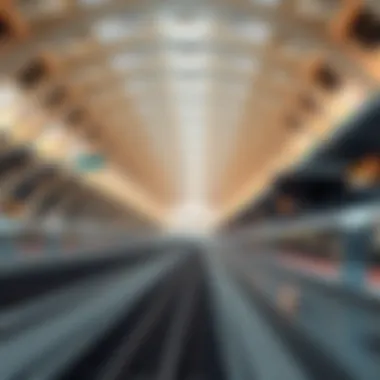
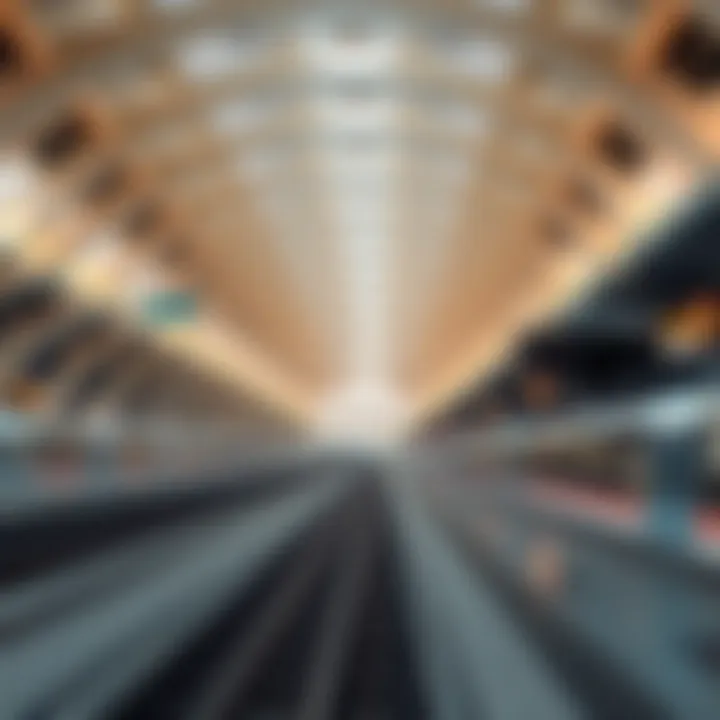
Environmental Considerations
The environmental aspects of urban transit systems like the Red Line of the Dubai Metro hold significant weight in today's world where sustainability is becoming imperative. The metro system stands not just as a transportation method, but also as a testament to Dubai's commitment to ecological awareness and reducing its overall environmental impact. The introduction of transit systems that rely on electric-powered trains reduces dependence on fossil fuels, contributing to a cleaner urban atmosphere. This section outlines two critical components: sustainability initiatives and reducing carbon footprint. Both elements highlight how the Red Line plays a role in enhancing both the local ecosystem and the quality of life for its residents.
Sustainability Initiatives
The Dubai Metro has implemented an array of initiatives aimed at promoting sustainability. These efforts are anchored on reducing energy consumption and enhancing the overall efficiency of public transport. For instance, the use of solar energy in powering certain aspects of the infrastructure is groundbreaking. With the harsh sun shining down in Dubai, harnessing solar power is a natural fit. The stations are equipped with solar panels that help to power lighting and signage, lessening the strain on conventional power sources.
Moreover, water conservation is a crucial feature. Smart water systems implemented in the stations ensure minimal water wastage. The integration of greywater recycling systems allows for the repurposing of water for irrigation and other non-potable uses, showcasing a dedication to preserving this precious resource.
Other Sustainability Efforts:
- Green Building Standards: Adherence to international standards for green buildings during station construction.
- Eco-Friendly Materials: Utilizing sustainable materials whenever possible in construction projects.
- Awareness Campaigns: Conducting educational programs to promote public transport use over personal vehicles.
Reducing Carbon Footprint
Reducing the carbon footprint is another focal point for the Red Line of the Dubai Metro. The introduction of this efficient public transport option significantly curtails reliance on private vehicles, thereby bringing down the total greenhouse gas emissions on the roads.
By inviting a larger number of residents and visitors to hop on the metro instead of driving, there’s a direct correlation to lowering overall traffic congestion. A study found that a single metro train can replace dozens of cars on the road, drastically reducing the emissions that contribute to air pollution.
Using energy-efficient trains also serves to mitigate impacts on the environment. The dynamic braking system allows trains to regenerate energy during braking, contributing to efficiency much needed in urban transit.
Sharply reducing the carbon footprint aligns perfectly with global goals for combating climate change. For potential investors, the environmental planning surrounding the Red Line can be viewed as a long-term investment in both economic growth and sustainable living. As urban areas increasingly prioritize their environmental standings, the adaptability of systems like the Dubai Metro only enhances their value.
In summary, the environmental considerations surrounding the Red Line are not merely box-checking measures; they represent a holistic approach to greener urban living.
Various resources complete the picture further, with reports from credible bodies on sustainability and urban transport strategies available at Britannica and Wikipedia. Further dialogue about public transport and urban ecology can be found on platforms like Reddit.
As the city advances in an era where sustainability is central, the Red Line stands as a model for how urban transportation can align itself with environmental stewardship.
Challenges and Future Prospects
The efficacy and expansion of the Red Line of the Dubai Metro reveal a complex interplay of challenges and future prospects. Examining these facets is crucial for understanding not only how the Metro services the city today but also how it evolves to meet future demands. Addressing these challenges does not only enhance operational efficiency but also presents unique investment opportunities and risks, making it essential for stakeholders to stay informed.
Current Operational Challenges
As with any major urban transport system, the Red Line faces its fair share of operational challenges. One notable issue is the increasing passenger congestion during peak hours. With Dubai's rapidly growing population, the number of daily commuters has surged, leading to overcrowded trains and stations. This congestion can diminish the otherwise smooth experience the Metro is known for, prompting the need for strategic adjustments.
Moreover, maintaining the integrity of the infrastructure is imperative. Extreme weather conditions, such as sandstorms, can adversely affect the rail systems, requiring costly maintenance and repairs. This challenge not only impacts operational efficiency but also the overall safety of the transit system.
Another sticking point is the competition from other transport modes such as taxis and ride-sharing services. With increased convenience and personalized service, many commuters opt for cars over the Metro. The challenge lies in retaining passengers while ensuring a competitive fare structure that adds value to using public transport.
In light of these issues, solutions such as increasing the frequency of trains and upgrading station facilities are being considered.
Future Expansion Plans
Looking ahead, the future of the Red Line appears promising yet demanding. Dubai has set ambitious expansion plans to not only extend the Red Line but also link it seamlessly with upcoming developments across the city. One significant project is the planned extension towards the Expo 2020 site, which is designed to enhance access for global events and connect multiple districts.
In addition to physical expansions, adopting smart technology will be a key aspect of future upgrades. Enhancements could include real-time monitoring of train schedules and maintenance alerts, reducing downtime and ensuring smoother operations. Also, employing data analytics can fine-tune service offerings based on commuter behavior, further optimizing travel experiences.
Investment opportunities are poised to grow with infrastructure enhancements. Increased connectivity will also naturally elevate the value of real estate in surrounding areas, enticing both local and international investors.
"The key to successful expansion lies in understanding the urban landscape's intricacies, balancing immediate needs with long-term sustainability and growth."\
Culmination
The conclusion of this article serves as both a reflection on the significance of the Red Line in the Dubai Metro system and a pragmatic guide for potential investors and residents. Through the lens of connectivity, the Red Line stands as a crowning achievement in urban planning, binding the various districts of Dubai together with a singular, efficient transport solution. It's more than just a mode of travel; it's an artery pumping life into the urban landscape.
Summarizing the Red Line's Impact
The Red Line has transformed how people navigate Dubai. It alleviates traffic congestion, promotes eco-friendly commuting, and enhances real estate value along its path. Notably, surrounding areas like Dubai Marina and Downtown Dubai have flourished due to increased accessibility to the metro. Moreover, the line has been a catalyst for local businesses by boosting foot traffic, thus fostering economic growth. With clean, reliable, and fast service, it has become a cornerstone for daily commuters, aligning with the broader vision of the city's development plan.
"Public transport systems, like the Red Line, redefine urban living, making it easier to access opportunities and enhancing quality of life."
This financial and social benefit extends beyond daily users, influencing developers and small business owners to invest. For residential buildings, proximity to the Red Line has become a unique selling proposition. Access to this transport link not only enhances the lifestyle of residents but also, invariably, their property value.
Considerations for Investors and Residents
For investors, understanding the Red Line's trajectory and future expansions can unlock significant opportunities. Areas near station entrances are prime real estate, often leading to higher demand and rental yields. Knowledge of market trends around these stations is essential. As the city's population continues to grow, the necessity for infrastructure that supports this growth becomes vital. Investors keen on tapping into Dubai's burgeoning real estate market should pay close attention to property developments along the Red Line.
Residents, on the flip side, find immense value in the convenience offered by the metro. Avoiding the hassle of traffic jams or high parking costs can make life considerably easier. It's not just about saving time; it's also about the environmental benefits and cost efficiency of commuting via public transport. Increased peace of mind and lowered daily stress from transport woes are advantages that residents can’t overlook. As the Red Line continues to evolve, it will inevitably hug the fabric of Dubai's everyday life closer with every passing metro train.
In sum, the future looks interconnected—both in terms of physical infrastructure and community development. The Red Line's impact, therefore, resonates far beyond what appears on the surface. It encapsulates a vision for a sustainable, accessible, and prosperous urban environment that encourages growth in both commercial and residential sectors.










